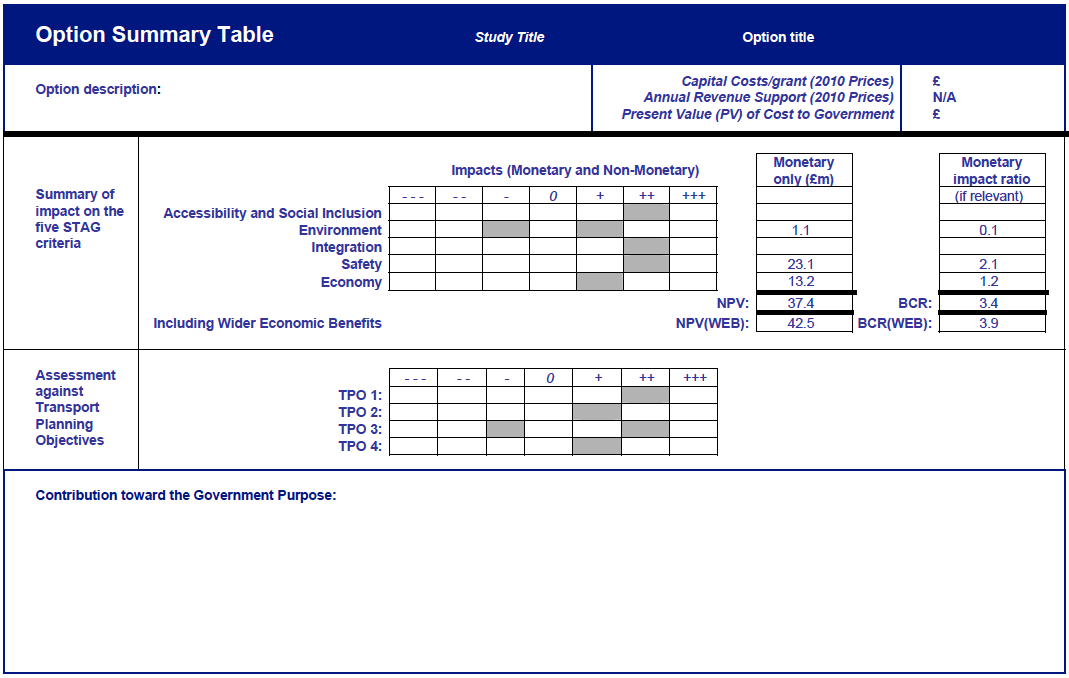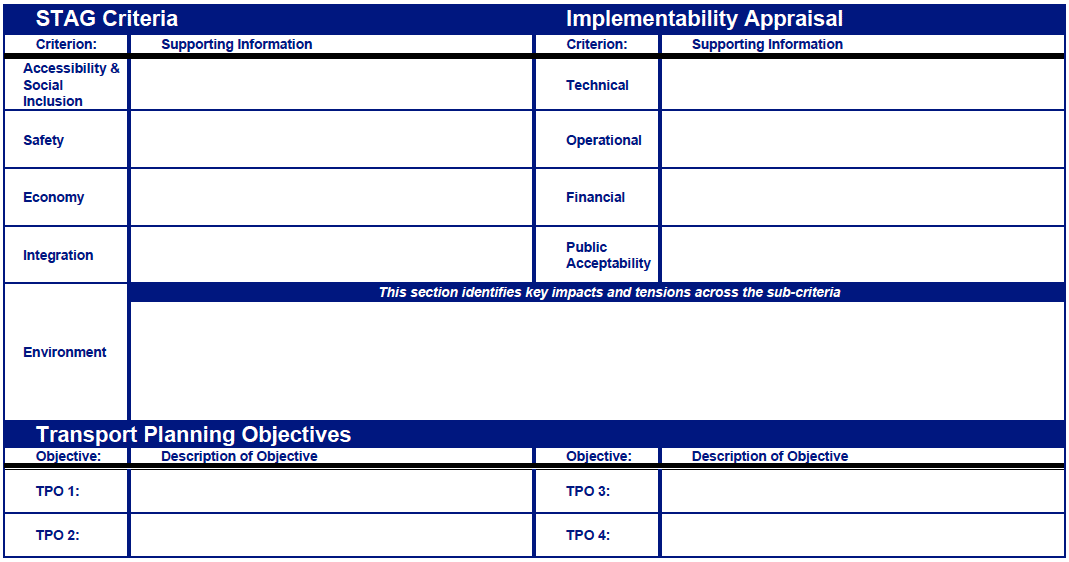Section 14
STAG Technical Database
Section 14
The STAG Report
January 2015
Version History
Changes since STAG Refresh, May 2008
| Change number | Section updated | Date |
| 1 | Price base year and base year for discounting have been updated to 2010 | November 2012 |
| 2 | Add references to Policy Assessment Framework | December 2013 |
| 3 | Enhancing guidance on the reporting of Transport Appraisals (continuous improvement) | January 2015 |
Contents
14. The STAG Report
14.1 Introduction
14.2 The Option Summary Table
This section outlines the general requirements for the reporting of appraisal work undertaken in support of any transport options for which the Scottish Government and/or Transport Scotland may provide funding or for which Scottish Government and/or Transport Scotland approval will be required. Practitioners may wish to consider adopting a similar format for submissions for funding within their own organisations.
All STAG study submissions to the Scottish Government and/or its agency Transport Scotland must be incorporated in the STAG Report. The STAG Report must reflect that STAG is one continuous process and the format must follow the structure of the Guidance:
- Introduction;
- Analysis of Problems and Opportunities;
- Objective Setting;
- Option Generation, Sifting and Development;
- Part 1 Appraisal;
- Part 1 Policy Assessment Framework charts
- Part 2 Appraisal;
- Cost to Government;
- Risk and Uncertainty;
- Option Summary Table
- Part 2 Policy Assessment Framework charts
- Monitoring Plan;
- Evaluation Plan; and
- Conclusions.
The aim of the STAG Report is to provide a concise summary of the work undertaken to demonstrate that the process of STAG described in STAG have been followed. Whilst the report should be concise, the size of the report will be determined by the complexity of the study undertaken. For this reason specific guidelines on the size of the reports are not included in the Guidance.
Where appropriate, the STAG Report should refer to any relevant technical reports, but should not normally include such technical reports.
All information contained in the STAG Report should be easy to read, that is, it should be clear, use non-technical language and present information in a logical manner using appropriate maps, diagrams or other illustration tools.
The Appraisal Summary Tables (ASTs) should be included as an appendix to the STAG Report and should not introduce new information that is not already included in the main body of the STAG Report.
It is important that the context and significance of the of the qualitative and quantitative outcomes are clearly set out to allow an understanding of the rationale for the results using the seven point scale assessment. Also, cumulative scoring of the individual results from the seven point scale assessment for an option is not acceptable as this can attribute inappropriate weighting to one or more individual elements of the Transport Appraisal.
Furthermore, the STAG Report should clearly set out how the views and information emerging from participation and consultation have been considered in the Transport Appraisal. It is recommended that the documents resulting from participation and consultation, for example notes of stakeholder workshops, are included as an appendix to the STAG Report.
To facilitate the clear presentation of information to decision makers, a Option Summary Table (OST) should be completed for each of the options that has passed the full STAG process. These tables should be included in the main report and not alongside the Appraisal Summary Tables in the annexes.
A suggested template for a OST is given below, and has been filled in as an example. It should be noted that the BCR can be calculated as the sum of the individual Economy, Environment, and Safety Monetary Impact Ratios.
The first half of the OST should briefly describe the option and use the Government seven point scale to rank the performance of the option against:
- The STAG criteria; and
- The SMART targets associated with the Transport Planning Objectives,
Where an option has both significant positive and negative impacts against a particular STAG criterion, these should be highlighted by providing more than one score on the seven point scale (see for example the Environment criterion in the OST below). Practitioners should avoid attempting to trade-off positive and negative impacts to present an overall or net impact, but should instead focus on ensuring that all relevant information is provided to the decision maker. The rankings given against each criteria should be explicitly justified in the STAG Report.
Capital costs/grants and annual revenue support should be given in undiscounted 2010 prices. The present value of Cost to Government should be reported as a discounted figure in 2010 prices as standard.
A commentary on the contribution of an option(s) satisfactorily completing the full STAG process to the Government's Purpose must be included in the STAG Report. This should be presented as part of the information included within the Option Summary Table. However, due to the degree of overlap between the STAG criteria and the Government's Purpose, the seven point scale should not be used, as this will lead to unnecessary duplication of information; a textual description only should be provided.
The second half of the OST should concisely outline the key impacts, whether they be positive or negative, against each of the STAG Criteria. For the Environment Criterion, it is particularly important that the supporting text should identify not only the key environmental impacts of the option, but also tensions that exist amongst the different Environment sub-criteria. All ten of the sub-criteria should be considered. It is likely that not all will have significant impacts or tensions and if this is the case they may be omitted from the OST. Where a scheme has significant impacts on CO2 emissions, the change in emissions should be reported against the Environment Criterion. A concise summary of the Implementability Appraisal should also be provided.
A description of each SMART Transport Planning Objective, together with its relevant target, should also be included.
When filling in the OST, practitioners should make use of all available information that has been gathered as part of the STAG process; however, it should be stressed that the aim of the OST is to provide a concise summary of an option, and practitioners should balance the need to provide detailed supplementary information against the decision makers' need to have relevant information presented in a clear and accessible manner. It is expected that decision makers would prefer that the information they receive take up no more than two sides of A4.
It is important to report separate monetary impact ratios across the Economy, Safety, and Environment criteria, as well as reporting the overall BCR. This will allow decision makers to assess the relative merits across criteria and make an informed decision.

